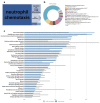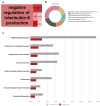Time Series Ovarian Transcriptome Analyses of the Porcine Estrous Cycle Reveals Gene Expression Changes during Steroid Metabolism and Corpus Luteum Development
- PMID: 35158699
- PMCID: PMC8833361
- DOI: 10.3390/ani12030376
Time Series Ovarian Transcriptome Analyses of the Porcine Estrous Cycle Reveals Gene Expression Changes during Steroid Metabolism and Corpus Luteum Development
Abstract
The porcine estrous cycle is influenced by reproductive hormones, which affect porcine reproduction and result in physiological changes in the reproductive organs. The ovary is involved in ovulation, luteinization, corpus luteum development, and luteolysis. Here, we aimed to provide a comprehensive understanding of the gene expression patterns in porcine ovarian transcriptomes during the estrous cycle through differentially expressed genes profiling and description of molecular mechanisms. The transcriptomes of porcine ovary were obtained during the estrous cycle at three-day intervals from day 0 to day 18 using RNA-seq. At seven time points of the estrous cycle, 4414 DEG were identified; these were classified into three clusters according to their expression patterns. During the late metestrus and diestrus periods, the expression in cluster 1 increased rapidly, and steroid biosynthesis was significant in the pathway. Cluster 2 gene expression patterns represented the cytokine-cytokine receptor interaction in significant pathways. In cluster 3, the hedgehog signaling pathway was selected as the significant pathway. Our study exhibited dynamic gene expression changes with these three different patterns of cluster 1, 2, and 3. The results helped identify the functions and related significant genes especially during the late metestrus and diestrus periods in the estrous cycle.
Keywords: corpus luteum; differentially expressed gene analysis; estrous cycle; gene expression; ovarian transcriptome; pigs.
Conflict of interest statement
The authors declare that there are no conflicts of interests.
Figures








References
-
- Zhang F.P., Ran X.Q. Changes in Ovary Transcriptome and Alternative splicing at estrus from Xiang pigs with Large and Small Litter Size. bioRxiv. 2019:547810. doi: 10.1101/547810. - DOI
Grants and funding
LinkOut - more resources
Full Text Sources

